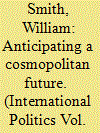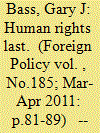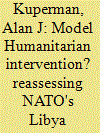| Srl | Item |
| 1 |
ID:
079471


|
|
|
|
|
| Publication |
2007.
|
| Summary/Abstract |
The past decade has witnessed the emergence of numerous 'cosmopolitan' theories of humanitarian military intervention. These theories anticipate a more cosmopolitan future, where interventions will be authorized by new cosmopolitan institutions and carried out by reformed cosmopolitan militaries. The contention of my article is that despite the merits of these approaches, it is often difficult to discern whether and how cosmopolitan theories can inform assessments of interventions that take place in our non-cosmopolitan present. Through taking Jürgen Habermas's judgements of two recent interventions as a 'case study', I reflect on the considerations that might come into play when cosmopolitans attempt to translate their future-orientated theories into practical engagements with the world as it
|
|
|
|
|
|
|
|
|
|
|
|
|
|
|
|
| 2 |
ID:
102866


|
|
|
| 3 |
ID:
122087


|
|
|
|
|
| Publication |
2013.
|
| Summary/Abstract |
NATO's 2011 humanitarian military intervention in Libya has been hailed as a model for implementing the emerging norm of the responsibility to protect (R2P), on grounds that it prevented an impending bloodbath in Benghazi and facilitated the ouster of Libya's oppressive ruler, Muammar al-Qaddafi, who had targeted peaceful civilian protesters. Before the international community embraces such conclusions, however, a more rigorous assessment of the net humanitarian impact of NATO intervention in Libya is warranted. The conventional narrative is flawed in its portrayal of both the nature of the violence in Libya prior to the intervention and NATO's eventual objective of regime change. An examination of the course of violence in Libya before and after NATO's action shows that the intervention backfired. The intervention extended the war's duration about sixfold; increased its death toll approximately seven to ten times; and exacerbated human rights abuses, humanitarian suffering, Islamic radicalism, and weapons proliferation in Libya and its neighbors. If it is a "model intervention," as senior NATO officials claim, it is a model of failure. Implementation of R2P must be reformed to address these unintended negative consequences and the dynamics underlying them. Only then will R2P be able to achieve its noble objectives.
|
|
|
|
|
|
|
|
|
|
|
|
|
|
|
|
| 4 |
ID:
195088


|
|
|
|
|
| Summary/Abstract |
Why are some violent intrastate crises more likely to prompt humanitarian military interventions than others? States appear to intervene robustly in reaction to some internal conflicts, such as Kosovo, but withhold similar options in more intense conflict, as in Darfur. Much of the research on this ‘selectivity gap’ focuses on universal norms or geopolitical interests. I, however, argue that the selectivity of these interventions is a product of regional variations interacting with conflict perceptions. This paper introduces a dataset of almost 1000 observations of intrastate armed conflict between 1989 and 2014, paired with international military responses and non-responses, as well as an Intervention Index that accounts for the intensity of military interventions. I find that once a threshold of human suffering is met via the existence of an internal armed conflict, powerful states will intervene depending on whether the conflict occurs in the Western sphere of influence and whether it is denoted as an identity war. A Western region coupled with no perceptions of identity-based civil war prompts the greatest odds of humanitarian military intervention. Such conclusions carry implications on the role of norms and interests in international politics, as biased by region, and for military intervention as a policy choice.
|
|
|
|
|
|
|
|
|
|
|
|
|
|
|
|